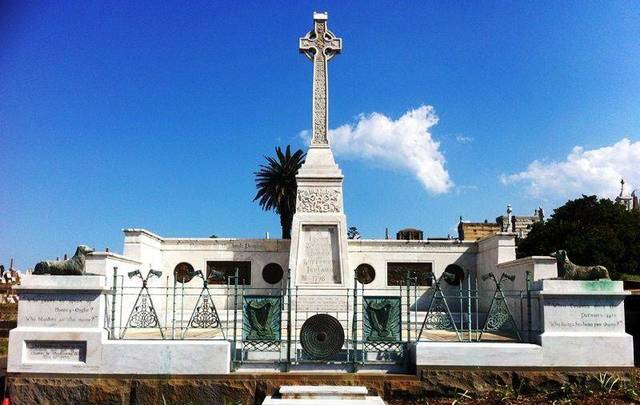Liam Neeson, Hollywood star and famous son of Ballymena in Co Antrim, and I were members of the same drama group, The Slemish Players, at different times. He went on to achieve more in that field than I did - my teaching endeavors took me to New Zealand.
I was teaching in Ballymena in 1986 and a day of protests by the loyalist and unionist community in Northern Ireland against an agreement by the Irish and British governments led to the country being mostly shut down.
The previous evening, a neighbor, who was not so friendly, and some mates gathered at his house. Most were armed.
The following day, he spotted me at my window and threatened me by marching up to it and just staring at me. It was time to leave. Initially, I intended to move to England but an advertisement in the local paper took me down under.
England was not really emigration, according to Gerry Anderson, a well-known radio presenter in Northern Ireland, who passed away too soon. Gerry coined the term ‘stroke-city’ to overcome the sectarian issue of calling the north-western city Derry or Londonderry. I had lived in the UK, studying and working with many Irish, so the opportunity to live somewhere different was inviting.
Dr. Marc Scully, a lecturer in psychology at Mary Immaculate College in Co Limerick who has studied the Irish diaspora in England, says that the ability to fly back to Ireland at short notice appears crucial to their identity, well-being, and resilience. This could be said for many Irish immigrants to Australia in more recent years, they could fly home in 24 hours, pre-pandemic. There has been a continuous movement of people between the islands of Ireland and Great Britain due to their proximity. This tide has ebbed and flowed in response to the politics, economics, and social conditions of both places.
The Belfast Telegraph is an evening paper in Northern Ireland and in 1986, I saw a column advising that New Zealand was recruiting lecturers and teachers and interviews were being held in Belfast. I attended the interview and was offered a job as Head of Computer Studies at Newlands College, Wellington.
We made a mighty decision to emigrate to New Zealand. A couple of years later, my wife Rosemary got a job in Sydney and we moved there. We liked Sydney’s climate and jobs were available.
I discovered there were thriving Irish communities in New Zealand and Australia. The Irish went everywhere and evidence of their migration is found in graveyards across the world. We lived near the Waverley graveyard in Sydney, which had many gravestone inscriptions that displayed the birthplaces of where many came from in Ireland and the UK. Many of the early immigrants died young.
It’s an iconic Australian landmark and heritage listed. Established in 1877, the site is located at the top of the Bronte Beach cliffs overlooking the Tasman Sea and contains over 80,000 burials and interments, many of which are decorated with Victorian and Edwardian monuments.
Recognized as one of the most beautiful cemeteries in the world, it is part of the picturesque coastal walk with Sydney’s famous Bondi Beach to the north. There is a truth in William Faulkner’s maxim, the past is not dead, it isn’t even past.

Love Irish history? Share your favorite stories with other history buffs in the IrishCentral History Facebook group.
I was amazed at the substantial memorial to the 1798 Irish Rebellion made of white Carrara marble with sculptures, plaques, inscriptions, medallions, and mosaics, topped with a 30-foot carved Celtic cross.
The memorial contains the interred remains of the leader of the revolutionary movement, Michael Dwyer, known as ‘The Wicklow Chief,' who died in 1825, and his wife, Mary. He is the most prominent Irish republican leader to be buried in the Southern Hemisphere.
Chiselled in the monument’s stone are the names of the executed leaders of the United Irishmen from 1798 and 1803 along with the names of the executed leaders of the 1916 Rebellion. Having fought in Wexford in 1798, Dwyer took to the Wicklow Hills and fought on until the end of 1803, when Robert Emmet’s Rebellion was finally quelled.
He arrived in Sydney on February 15, 1806, with his wife, Mary, on the convict ship Telicherry. The Irish community still gathers at 2 pm every Easter Sunday at the Waverley Monument to honor all those who fought and died for Ireland’s freedom.
Among the inscriptions decorating the memorial is the following translated from Gaelic: “People of Ireland, treasure the memory of the deeds of your ancestors. The warriors die but the true cause lasts forever.”
The memorial also features a plaque honoring Bobby Sands and the nine other H-Blocks Hunger Strikers who died in 1981.
*Hugh Vaughan has written several books of Irish interest, a memoir called Borderland, Cillefoyle Park based on a true 'back channel' between the IRA and the British government, and An Analytic Pub Crawl, a series of essays, including Irish humor, emigration, contemporary Irish politics, economy and more. See his website for details - hmvaughan.com.
This article was submitted to the IrishCentral contributors network by a member of the global Irish community. To become an IrishCentral contributor click here.




Comments